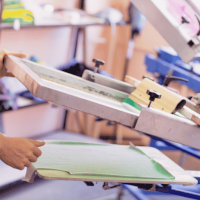Unlock the secrets of squeegees printing with expert tips on using squeegees for precise ink distribution and high-quality prints. Learn about the best angles and techniques for optimal results.
Introduction to Squeegees Printing
Squeegees printing is a cornerstone technique in the realms of printmaking and graphic design. Whether you are a seasoned professional or an enthusiastic hobbyist, mastering the use of a squeegee can dramatically elevate the quality and consistency of your prints. This article will explore the nuances of squeegees printing, from the fundamentals of what a squeegee is to the optimal techniques for achieving the best results.
What is a Squeegee in Printing?
A squeegee is an indispensable tool in the printing process, especially in screen printing and other printmaking methods. Typically made from rubber or plastic, it features a flat, flexible blade attached to a handle. Its primary function is to spread ink evenly across a screen or printing plate, ensuring that the design is accurately transferred onto the substrate. In squeegees printing, the squeegee is crucial for controlling ink distribution and achieving high-quality prints.
What is the Best Angle for Printing?
One of the most critical aspects of squeegees printing is determining the optimal squeegee angle. The angle at which the squeegee is held can significantly affect the print quality. Generally, an angle of 45 to 60 degrees is considered ideal for most printing applications. This angle allows for smooth ink distribution and minimizes the risk of ink buildup or uneven application. However, the best angle may vary depending on the specific printing process, the type of ink, and the substrate material. Experimentation and practice are essential for finding the perfect angle for your setup.

What is the Proper Way to Use a Squeegee?
Using a squeegee correctly is essential for achieving professional results in squeegees printing. Here are some key tips for proper squeegee usage:
- Preparation: Ensure the squeegee is clean and free of debris or dried ink. A clean squeegee ensures smoother and more consistent ink application.
- Grip: Hold the squeegee firmly but not too tightly. A relaxed grip allows for better control and reduces hand fatigue during the printing process.
- Angle: Maintain an optimal angle of around 45 to 60 degrees. This angle helps evenly distribute the ink and prevents streaks or uneven coverage.
- Speed: Move the squeegee at a steady, moderate speed. Too fast, and the ink may not spread evenly; too slow, and the ink may accumulate, leading to blotches.
- Pressure: Apply consistent pressure as you pull the squeegee across the screen. Uneven pressure can result in inconsistent ink transfer and affect the final print quality.
- Cleaning: Clean the squeegee thoroughly after each use to remove any residual ink. This ensures the squeegee remains in good condition and ready for the next printing session.
Which Printmaking Process Uses a Squeegee to Distribute the Ink?
Squeegees are most commonly used in screen printing, also known as serigraphy. In this process, a mesh screen is stretched over a frame, and a stencil is applied to create the desired design. The squeegee is then used to push ink through the open areas of the stencil, transferring the design onto the substrate below. The squeegee’s ability to evenly distribute ink makes it an essential tool in screen printing, ensuring accurate and consistent reproduction of the design.
Which Printing Process Requires a Squeegee?
While screen printing is the most well-known process that requires a squeegee, other printmaking techniques also utilize squeegees for ink distribution. For example, in monotype printing, a squeegee can be used to spread ink on a smooth surface before transferring the design onto paper. Additionally, some artists use squeegees in mixed-media works to create unique textures and effects. The versatility of the squeegee makes it a valuable tool across various printing processes, enhancing the precision and control of ink application.
What is the Purpose of a Squeegee?
The primary purpose of a squeegee in printing is to ensure even ink distribution and accurate design transfer. By controlling the amount of ink applied and the pressure used, a squeegee helps achieve high-quality prints with consistent color and detail. Additionally, squeegees are used to remove excess ink from the screen or printing plate, preventing smudging or bleeding of the design. In essence, the squeegee is a crucial tool for maintaining the integrity and quality of the printed image.
What is a Squeegee in Graphic Design?
In graphic design, a squeegee is often used in screen printing to transfer designs onto various substrates. Graphic designers use squeegees to apply ink through a stencil on a mesh screen, creating vibrant and detailed prints. The squeegee allows designers to achieve precise control over the ink application, ensuring that the final printed product accurately reflects the original design. Whether creating posters, t-shirts, or other printed materials, a squeegee is an essential tool for any graphic designer working with screen printing techniques.
Conclusion
Squeegees printing is a versatile and essential technique in the world of printmaking and graphic design. Understanding the proper use of a squeegee, including the optimal angle and technique, can significantly enhance the quality and consistency of your prints. Whether you are working with screen printing, monotype, or other printmaking processes, a squeegee is a valuable tool for achieving precise ink distribution and accurate design transfer. By mastering the art of squeegees printing, you can elevate your printmaking skills and create stunning, high-quality prints.










